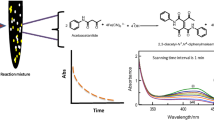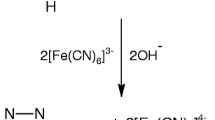Abstract
The oxidation of hydroquinone by environmentally benign tetrabutyl ammonium tribromide (TBATB) was carried out in 50% V/V aqueous acetic acid medium under pseudo-first-order conditions, keeping a large excess of hydroquinone over the oxidant. The main reactive species of oxidant and substrate were found to be the \(\mathrm{Br}_{3}^{-}\) ion and hydroquinone, respectively. The reaction proceeds with prior complex formation between the reactants followed by its slow decomposition to generate semiquinone and bromine radicals. The complex formation was kinetically verified by its Michaelis–Menten plot. The solvent effect was verified by using Grunwald–Winstein equation which is consistent with an SN2 mechanism. The formation constants for the complex and rate constant for the slow decomposition step were determined by studying the reaction at five different temperatures. The values of formation constant of the complex and the rate constant for its decomposition were determined at these temperatures. The activation parameters with respect to the slow step of the reaction have also been determined.
Similar content being viewed by others
References
Brodovitch, J.C., McAuley, A., Oswald, T.: Kinetics and mechanism of oxidation of hydroquinone and catechol by [NiIIIcyclam]3+ in aqueous perchlorate media. Inorg. Chem. 21, 3442–3447 (1982)
Macartney, D.H., McAuley, A.: Mechanisms of reduction of nickel(IV) oxime complex by 1,2 and 1,4-dihydroxybenzene compounds in aqueous perchlorate media. J. Chem. Soc. Dalton Trans. 103–108 (1984)
Giraudi, G., Mentasti, E.: The kinetics and mechanisms of oxidation of dihydroxynbenzenes by ethylenediaminetetraacetatomanganate(III). Transition Met. Chem. 6, 230–234 (1981)
Herbert, J.W., Macartney, D.H.: Kinetics of the reduction of a tetra-m-acetato-dirhodium cation by substituted 1,2- and 1,4-dihydroxybenzene compounds in aqueous perchlorate media. J. Chem. Soc. Dalton Trans. 1931–1935 (1986)
Castro, C.E., Hathway, G.M., Havlin, R.: Oxidation and reduction of iron porphyrins and hemoproteins by quinones and hydroquinones. J. Am. Chem. Soc. 99, 8032–8039 (1977)
Clemmer, J.D., Hogaboom, G.K., Holwerda, R.A.: Reduction of the bis(2,9-dimethyl-1,10-phenanthroline) copper(II) ion by substituted hydroquinones. Inorg. Chem. 18, 2567–2572 (1979)
Hoddenbagh, J.M.A., Macartney, D.H.: Kinetics of the oxidation of ascorbic acid and substituted 1,2- and 1,4-dihyroxybenzenes by the hexacyanoruthenate(III) ion in acidic perchlorate media. J. Chem. Soc. Dalton Trans. 615–620 (1990)
Lam, W.W.Y., Lee, M.F.W., Lau, T.C.: Kinetics and mechanism of the oxidation of hydroquinones by a trans-dioxoruthenium(VI) complex. Inorg. Chem. 45, 315–321 (2006)
Binstead, R.A., McGuire, M.E., Dovletoglou, A., Seok, W.K., Roecker, L.E., Meyer, T.J.: Oxidation of hydroquinones by ruthenium complexes, proton-coupled electron transfer. J. Am. Chem. Soc. 114, 173–186 (1992)
Kustin, K., Liu, S.T., Nicolini, C., Toppen, D.L.: Interaction of catechol and catechol derivatives with dioxovanadium(V). I. Kinetics of complex formation in acidic media. J. Am. Chem. Soc. 96, 7410–7415 (1974)
Kamau, P., Jordan, R.B.: Kinetic study of the oxidation of catechol by aqueous copper(II). Inorg. Chem. 41, 3076–3083 (2002)
Bhattacharyya, J., Mukhopadhyay, S.: Mechanistic studies on the oxidation of hydroquinone by an oxo-bridged diiron(III,III) complex in weakly acidic aqueous media. Transition Met. Chem. 31, 256–261 (2006)
Kajigaeshi, S., Kakinami, T., Okamoto, T., Fujisaki, S.: Synthesis of bromoacetyl derivatives by use of tetrabutylammonium tribromide. Bull. Chem. Soc. Jpn. 60, 1159–1160 (1987)
Mondal, E., Bose, G., Khan, A.T.: An expedient and efficient method for the cleavage of dithioacetals to the corresponding carbonyl compounds using organic ammonium tribromide (OATB). Synlett 6, 785–786 (2001)
Zende, S.N., Kalantre, V.A., Gokavi, G.S.: Oxidation of dimethyl and diphenyl sulfoxides by tetrabutylammonium tribromide. J. Sulfur Chem. 29, 171–178 (2008)
Kalantre, V.A., Mardur, S.P., Gokavi, G.S.: Oxidation of vanadium (IV) by tetrabutylammonium tribromide. Transition Met. Chem. 32, 214–218 (2007)
Baghmar, M., Sharma, P.K.: Kinetics and mechanism of oxidation of aliphatic alcohols by tetrabutylammonium tribromide. Proc. Indian Acad. Sci. Chem. Sci. 113, 138–146 (2001)
Gosain, J., Sharma, P.K.: Kinetics and mechanism of oxidation of some vicinal and non-vicinal diols by tetrabutylammonium tribromide. Proc. Indian Acad. Sci. Chem. Sci. 115, 135–145 (2003)
Vogel, A.I.: Practical Organic Chemistry, 4th edn. Longman, Harlow (1978), p. 788
Lurie, J.: Handbook of Analytical Chemistry, p. 301. Mir, Moscow (1975)
Beitz, T., Bechmann, W., Mitzner, R.: Investigation of reactions of selected azaarenes with radicals in water. 2. Chlorine and bromine radicals. J. Phys. Chem. A 102, 6766–6771 (1998)
Wong, S.K., Sytnyk, W., Wan, J.K.S.: Electron spin resonance study of the self-disproportionation of some semiquinone radicals in solution. Can. J. Chem. 50, 3052–3057 (1972)
Grunwald, E., Winstein, S.: The correlation of solvolysis rates. J. Am. Chem. Soc. 70, 846–854 (1948)
Author information
Authors and Affiliations
Corresponding author
Rights and permissions
About this article
Cite this article
Zende, S.N., Kalantre, V.A. & Gokavi, G.S. Kinetics and Mechanism of Oxidation of Hydroquinone by Tetrabutylammonium Tribromide Ion in Aqueous Acetic Acid. J Solution Chem 39, 1178–1186 (2010). https://doi.org/10.1007/s10953-010-9567-0
Received:
Accepted:
Published:
Issue Date:
DOI: https://doi.org/10.1007/s10953-010-9567-0




